Assessment 2 Report: Analysis of Clinical Database Management Systems
VerifiedAdded on 2020/04/01
|7
|1433
|44
Report
AI Summary
This report analyzes a student's assessment of a clinical database management system, focusing on an article titled 'How I do it: A Practical Database Management System to Assist Clinical Research Teams with Data Collecting, Organization, and Reporting.' The report explores the article's purpose, which is to propose a user-friendly and efficient system for data storage and retrieval in clinical research. It details the technologies involved, including MySQL and MS Access, and the data gathering approach through questionnaires administered to interventional radiologists. The report highlights the outcomes, such as time savings in data filtering and categorization, and provides a critical analysis, discussing the limitations of relational databases for large-scale clinical research and advocating for the use of big data. The report also suggests improvements to the information-gathering methods and GUI design. The bibliography includes relevant sources like Castaneda et al. (2015), Chou et al. (2016), Elsaadany et al. (2017), and Yao (2017).
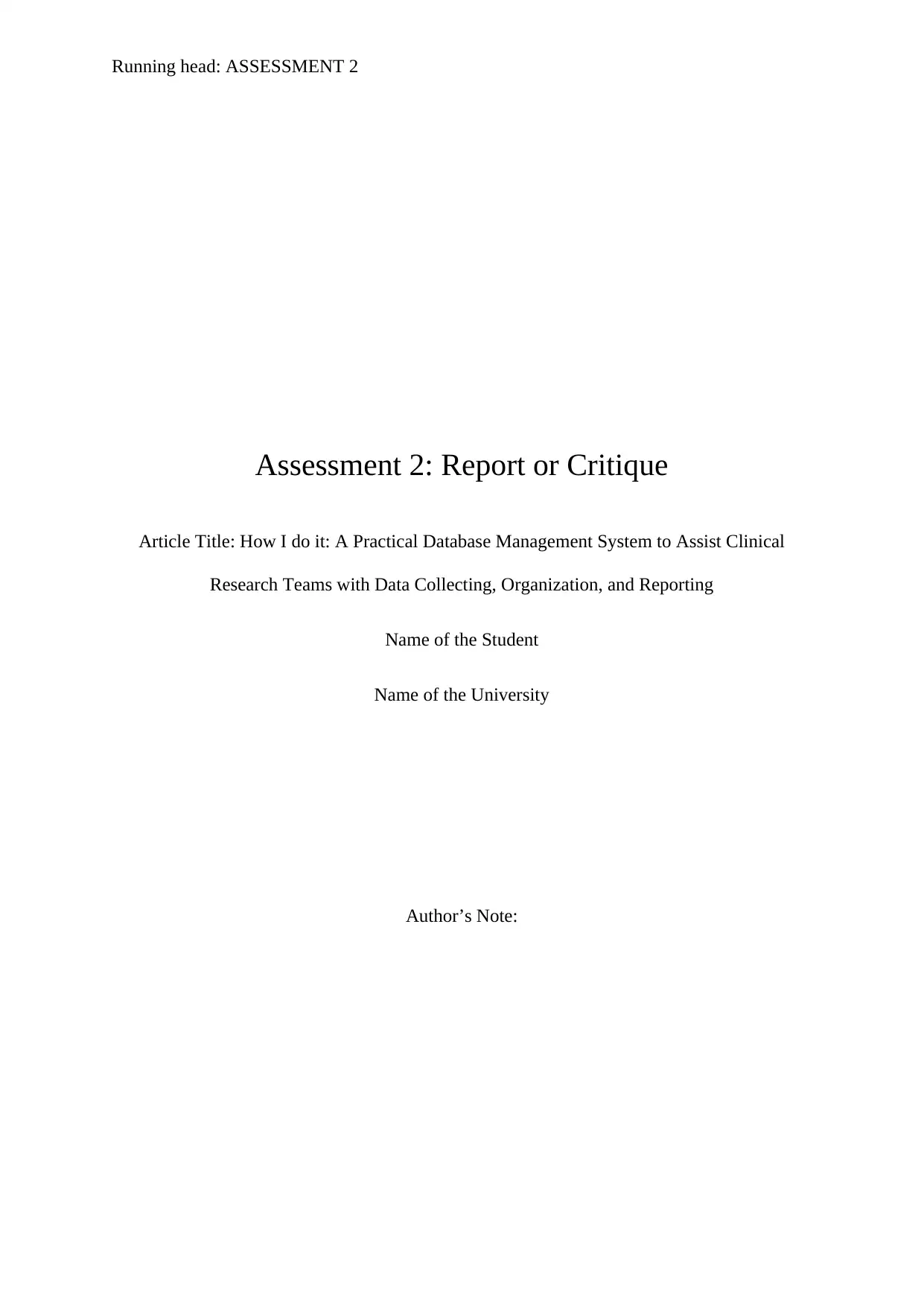
Running head: ASSESSMENT 2
Assessment 2: Report or Critique
Article Title: How I do it: A Practical Database Management System to Assist Clinical
Research Teams with Data Collecting, Organization, and Reporting
Name of the Student
Name of the University
Author’s Note:
Assessment 2: Report or Critique
Article Title: How I do it: A Practical Database Management System to Assist Clinical
Research Teams with Data Collecting, Organization, and Reporting
Name of the Student
Name of the University
Author’s Note:
Paraphrase This Document
Need a fresh take? Get an instant paraphrase of this document with our AI Paraphraser
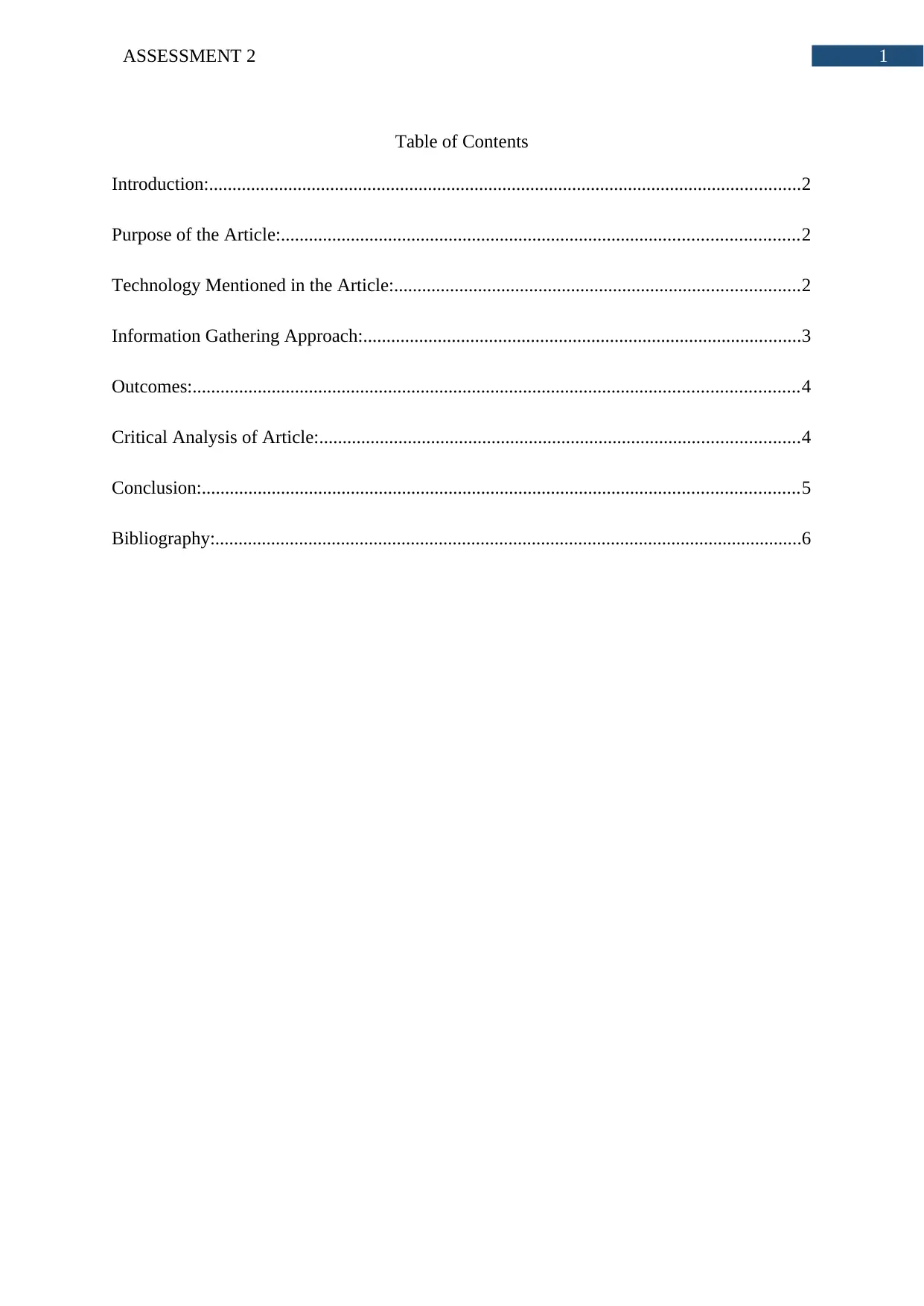
1ASSESSMENT 2
Table of Contents
Introduction:...............................................................................................................................2
Purpose of the Article:...............................................................................................................2
Technology Mentioned in the Article:.......................................................................................2
Information Gathering Approach:..............................................................................................3
Outcomes:..................................................................................................................................4
Critical Analysis of Article:.......................................................................................................4
Conclusion:................................................................................................................................5
Bibliography:..............................................................................................................................6
Table of Contents
Introduction:...............................................................................................................................2
Purpose of the Article:...............................................................................................................2
Technology Mentioned in the Article:.......................................................................................2
Information Gathering Approach:..............................................................................................3
Outcomes:..................................................................................................................................4
Critical Analysis of Article:.......................................................................................................4
Conclusion:................................................................................................................................5
Bibliography:..............................................................................................................................6
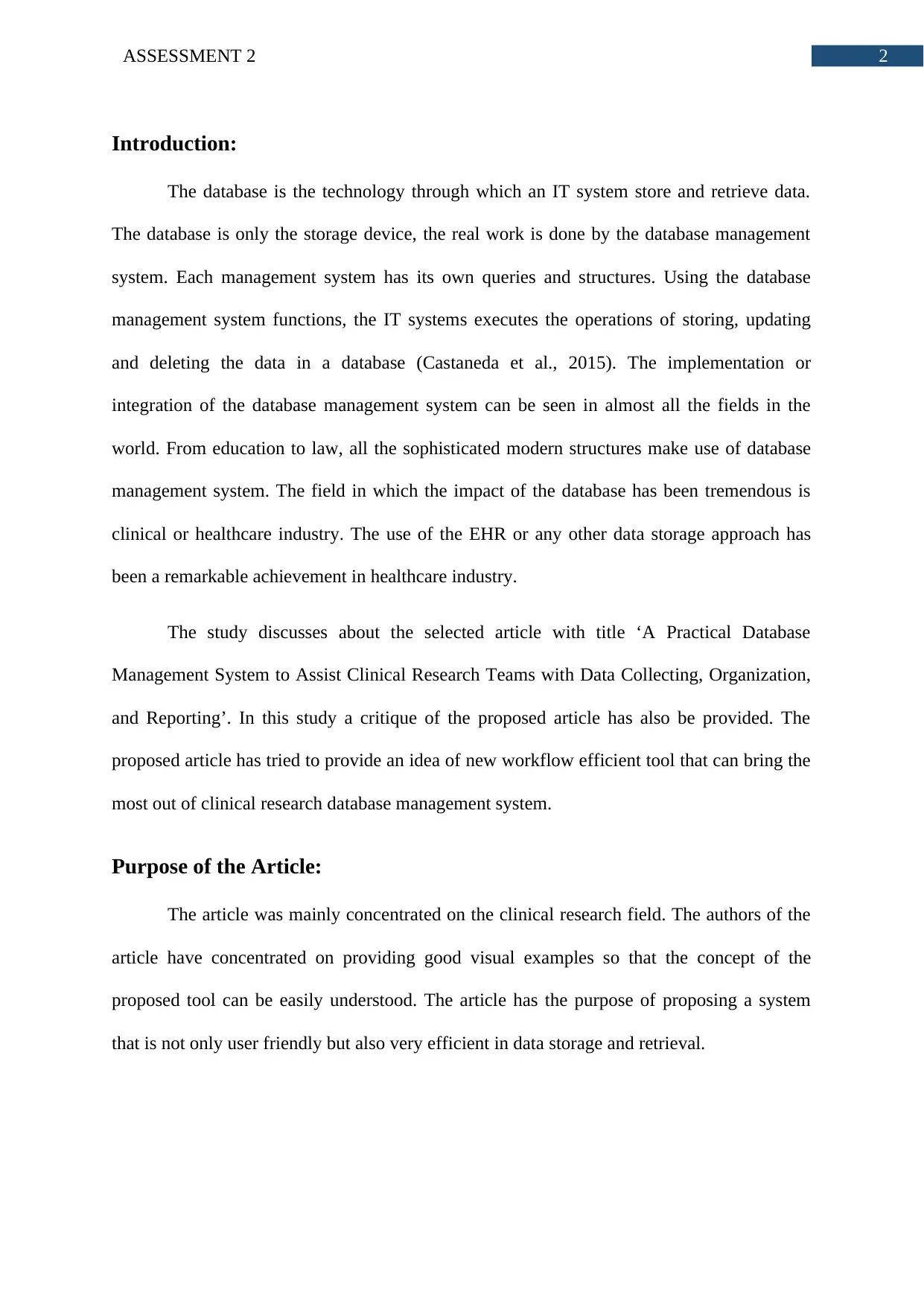
2ASSESSMENT 2
Introduction:
The database is the technology through which an IT system store and retrieve data.
The database is only the storage device, the real work is done by the database management
system. Each management system has its own queries and structures. Using the database
management system functions, the IT systems executes the operations of storing, updating
and deleting the data in a database (Castaneda et al., 2015). The implementation or
integration of the database management system can be seen in almost all the fields in the
world. From education to law, all the sophisticated modern structures make use of database
management system. The field in which the impact of the database has been tremendous is
clinical or healthcare industry. The use of the EHR or any other data storage approach has
been a remarkable achievement in healthcare industry.
The study discusses about the selected article with title ‘A Practical Database
Management System to Assist Clinical Research Teams with Data Collecting, Organization,
and Reporting’. In this study a critique of the proposed article has also be provided. The
proposed article has tried to provide an idea of new workflow efficient tool that can bring the
most out of clinical research database management system.
Purpose of the Article:
The article was mainly concentrated on the clinical research field. The authors of the
article have concentrated on providing good visual examples so that the concept of the
proposed tool can be easily understood. The article has the purpose of proposing a system
that is not only user friendly but also very efficient in data storage and retrieval.
Introduction:
The database is the technology through which an IT system store and retrieve data.
The database is only the storage device, the real work is done by the database management
system. Each management system has its own queries and structures. Using the database
management system functions, the IT systems executes the operations of storing, updating
and deleting the data in a database (Castaneda et al., 2015). The implementation or
integration of the database management system can be seen in almost all the fields in the
world. From education to law, all the sophisticated modern structures make use of database
management system. The field in which the impact of the database has been tremendous is
clinical or healthcare industry. The use of the EHR or any other data storage approach has
been a remarkable achievement in healthcare industry.
The study discusses about the selected article with title ‘A Practical Database
Management System to Assist Clinical Research Teams with Data Collecting, Organization,
and Reporting’. In this study a critique of the proposed article has also be provided. The
proposed article has tried to provide an idea of new workflow efficient tool that can bring the
most out of clinical research database management system.
Purpose of the Article:
The article was mainly concentrated on the clinical research field. The authors of the
article have concentrated on providing good visual examples so that the concept of the
proposed tool can be easily understood. The article has the purpose of proposing a system
that is not only user friendly but also very efficient in data storage and retrieval.
⊘ This is a preview!⊘
Do you want full access?
Subscribe today to unlock all pages.

Trusted by 1+ million students worldwide
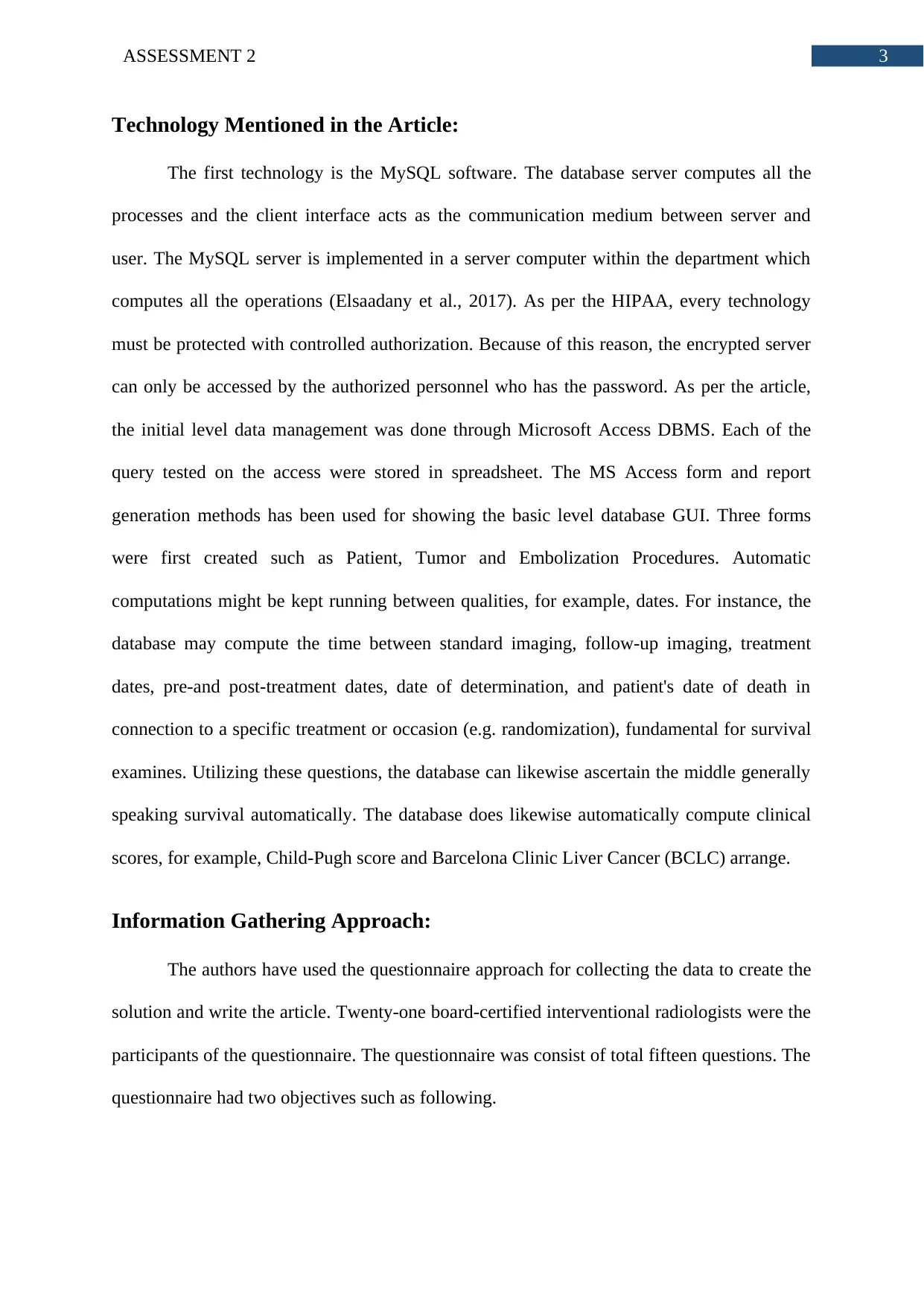
3ASSESSMENT 2
Technology Mentioned in the Article:
The first technology is the MySQL software. The database server computes all the
processes and the client interface acts as the communication medium between server and
user. The MySQL server is implemented in a server computer within the department which
computes all the operations (Elsaadany et al., 2017). As per the HIPAA, every technology
must be protected with controlled authorization. Because of this reason, the encrypted server
can only be accessed by the authorized personnel who has the password. As per the article,
the initial level data management was done through Microsoft Access DBMS. Each of the
query tested on the access were stored in spreadsheet. The MS Access form and report
generation methods has been used for showing the basic level database GUI. Three forms
were first created such as Patient, Tumor and Embolization Procedures. Automatic
computations might be kept running between qualities, for example, dates. For instance, the
database may compute the time between standard imaging, follow-up imaging, treatment
dates, pre-and post-treatment dates, date of determination, and patient's date of death in
connection to a specific treatment or occasion (e.g. randomization), fundamental for survival
examines. Utilizing these questions, the database can likewise ascertain the middle generally
speaking survival automatically. The database does likewise automatically compute clinical
scores, for example, Child-Pugh score and Barcelona Clinic Liver Cancer (BCLC) arrange.
Information Gathering Approach:
The authors have used the questionnaire approach for collecting the data to create the
solution and write the article. Twenty-one board-certified interventional radiologists were the
participants of the questionnaire. The questionnaire was consist of total fifteen questions. The
questionnaire had two objectives such as following.
Technology Mentioned in the Article:
The first technology is the MySQL software. The database server computes all the
processes and the client interface acts as the communication medium between server and
user. The MySQL server is implemented in a server computer within the department which
computes all the operations (Elsaadany et al., 2017). As per the HIPAA, every technology
must be protected with controlled authorization. Because of this reason, the encrypted server
can only be accessed by the authorized personnel who has the password. As per the article,
the initial level data management was done through Microsoft Access DBMS. Each of the
query tested on the access were stored in spreadsheet. The MS Access form and report
generation methods has been used for showing the basic level database GUI. Three forms
were first created such as Patient, Tumor and Embolization Procedures. Automatic
computations might be kept running between qualities, for example, dates. For instance, the
database may compute the time between standard imaging, follow-up imaging, treatment
dates, pre-and post-treatment dates, date of determination, and patient's date of death in
connection to a specific treatment or occasion (e.g. randomization), fundamental for survival
examines. Utilizing these questions, the database can likewise ascertain the middle generally
speaking survival automatically. The database does likewise automatically compute clinical
scores, for example, Child-Pugh score and Barcelona Clinic Liver Cancer (BCLC) arrange.
Information Gathering Approach:
The authors have used the questionnaire approach for collecting the data to create the
solution and write the article. Twenty-one board-certified interventional radiologists were the
participants of the questionnaire. The questionnaire was consist of total fifteen questions. The
questionnaire had two objectives such as following.
Paraphrase This Document
Need a fresh take? Get an instant paraphrase of this document with our AI Paraphraser
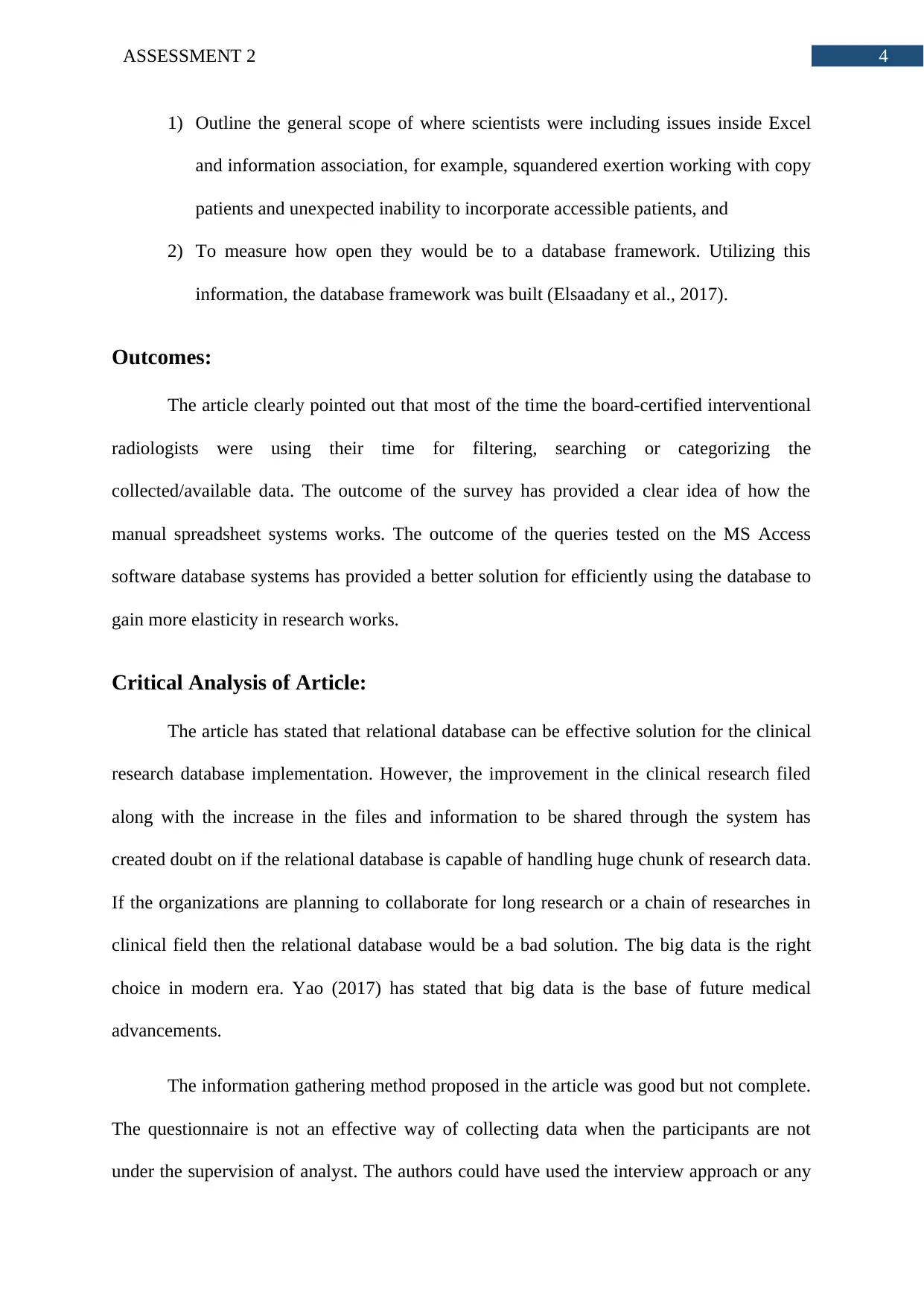
4ASSESSMENT 2
1) Outline the general scope of where scientists were including issues inside Excel
and information association, for example, squandered exertion working with copy
patients and unexpected inability to incorporate accessible patients, and
2) To measure how open they would be to a database framework. Utilizing this
information, the database framework was built (Elsaadany et al., 2017).
Outcomes:
The article clearly pointed out that most of the time the board-certified interventional
radiologists were using their time for filtering, searching or categorizing the
collected/available data. The outcome of the survey has provided a clear idea of how the
manual spreadsheet systems works. The outcome of the queries tested on the MS Access
software database systems has provided a better solution for efficiently using the database to
gain more elasticity in research works.
Critical Analysis of Article:
The article has stated that relational database can be effective solution for the clinical
research database implementation. However, the improvement in the clinical research filed
along with the increase in the files and information to be shared through the system has
created doubt on if the relational database is capable of handling huge chunk of research data.
If the organizations are planning to collaborate for long research or a chain of researches in
clinical field then the relational database would be a bad solution. The big data is the right
choice in modern era. Yao (2017) has stated that big data is the base of future medical
advancements.
The information gathering method proposed in the article was good but not complete.
The questionnaire is not an effective way of collecting data when the participants are not
under the supervision of analyst. The authors could have used the interview approach or any
1) Outline the general scope of where scientists were including issues inside Excel
and information association, for example, squandered exertion working with copy
patients and unexpected inability to incorporate accessible patients, and
2) To measure how open they would be to a database framework. Utilizing this
information, the database framework was built (Elsaadany et al., 2017).
Outcomes:
The article clearly pointed out that most of the time the board-certified interventional
radiologists were using their time for filtering, searching or categorizing the
collected/available data. The outcome of the survey has provided a clear idea of how the
manual spreadsheet systems works. The outcome of the queries tested on the MS Access
software database systems has provided a better solution for efficiently using the database to
gain more elasticity in research works.
Critical Analysis of Article:
The article has stated that relational database can be effective solution for the clinical
research database implementation. However, the improvement in the clinical research filed
along with the increase in the files and information to be shared through the system has
created doubt on if the relational database is capable of handling huge chunk of research data.
If the organizations are planning to collaborate for long research or a chain of researches in
clinical field then the relational database would be a bad solution. The big data is the right
choice in modern era. Yao (2017) has stated that big data is the base of future medical
advancements.
The information gathering method proposed in the article was good but not complete.
The questionnaire is not an effective way of collecting data when the participants are not
under the supervision of analyst. The authors could have used the interview approach or any
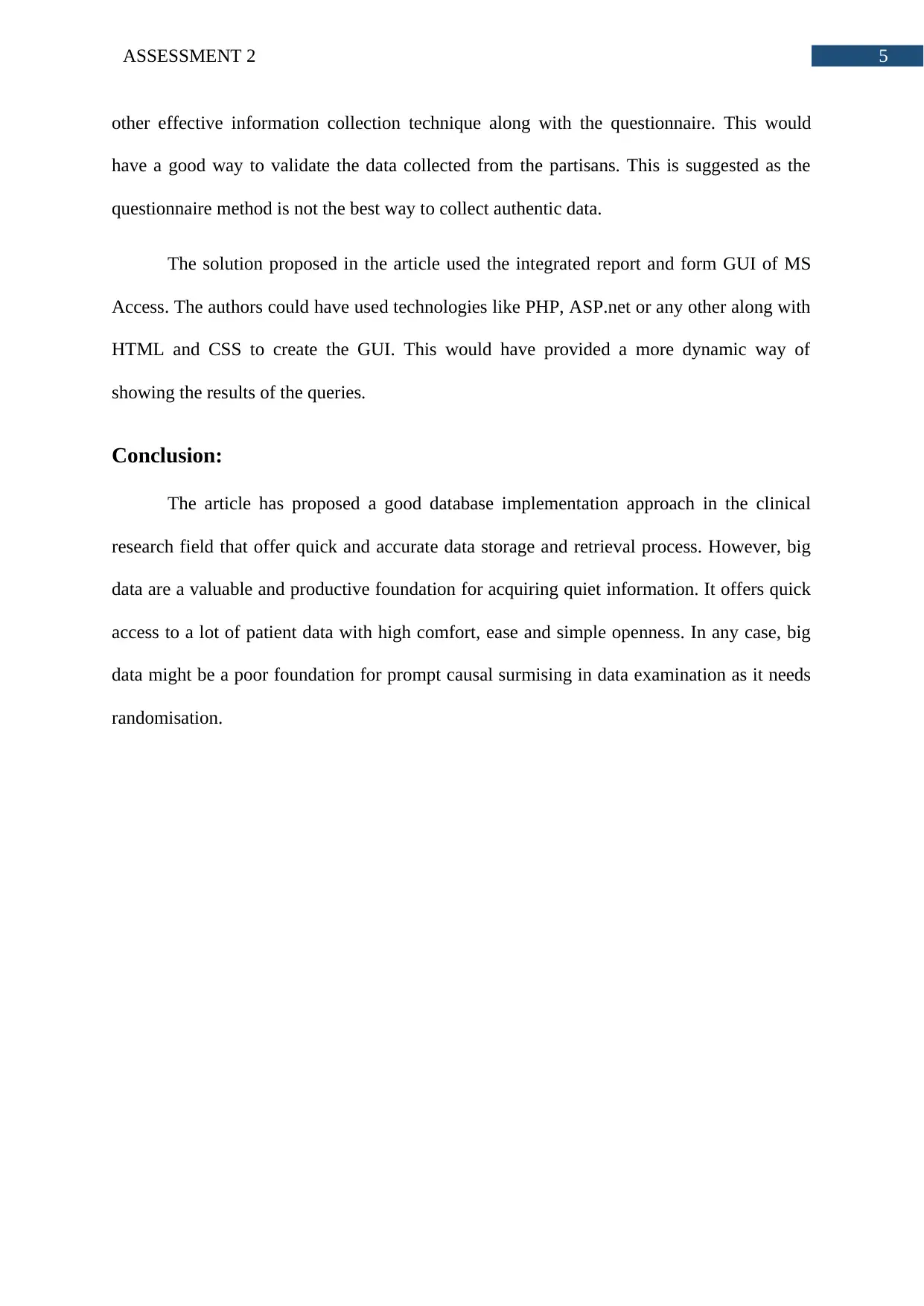
5ASSESSMENT 2
other effective information collection technique along with the questionnaire. This would
have a good way to validate the data collected from the partisans. This is suggested as the
questionnaire method is not the best way to collect authentic data.
The solution proposed in the article used the integrated report and form GUI of MS
Access. The authors could have used technologies like PHP, ASP.net or any other along with
HTML and CSS to create the GUI. This would have provided a more dynamic way of
showing the results of the queries.
Conclusion:
The article has proposed a good database implementation approach in the clinical
research field that offer quick and accurate data storage and retrieval process. However, big
data are a valuable and productive foundation for acquiring quiet information. It offers quick
access to a lot of patient data with high comfort, ease and simple openness. In any case, big
data might be a poor foundation for prompt causal surmising in data examination as it needs
randomisation.
other effective information collection technique along with the questionnaire. This would
have a good way to validate the data collected from the partisans. This is suggested as the
questionnaire method is not the best way to collect authentic data.
The solution proposed in the article used the integrated report and form GUI of MS
Access. The authors could have used technologies like PHP, ASP.net or any other along with
HTML and CSS to create the GUI. This would have provided a more dynamic way of
showing the results of the queries.
Conclusion:
The article has proposed a good database implementation approach in the clinical
research field that offer quick and accurate data storage and retrieval process. However, big
data are a valuable and productive foundation for acquiring quiet information. It offers quick
access to a lot of patient data with high comfort, ease and simple openness. In any case, big
data might be a poor foundation for prompt causal surmising in data examination as it needs
randomisation.
⊘ This is a preview!⊘
Do you want full access?
Subscribe today to unlock all pages.

Trusted by 1+ million students worldwide
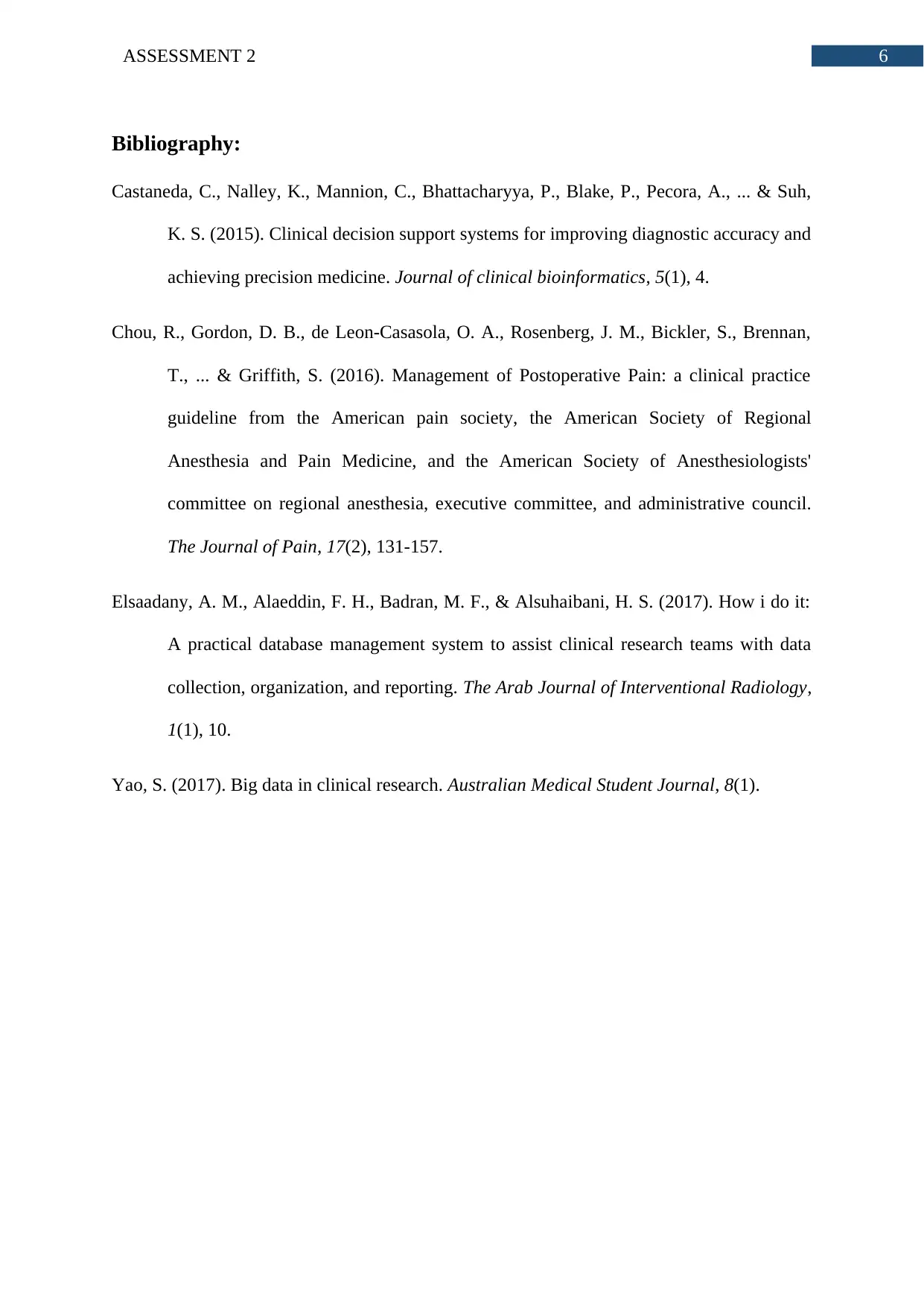
6ASSESSMENT 2
Bibliography:
Castaneda, C., Nalley, K., Mannion, C., Bhattacharyya, P., Blake, P., Pecora, A., ... & Suh,
K. S. (2015). Clinical decision support systems for improving diagnostic accuracy and
achieving precision medicine. Journal of clinical bioinformatics, 5(1), 4.
Chou, R., Gordon, D. B., de Leon-Casasola, O. A., Rosenberg, J. M., Bickler, S., Brennan,
T., ... & Griffith, S. (2016). Management of Postoperative Pain: a clinical practice
guideline from the American pain society, the American Society of Regional
Anesthesia and Pain Medicine, and the American Society of Anesthesiologists'
committee on regional anesthesia, executive committee, and administrative council.
The Journal of Pain, 17(2), 131-157.
Elsaadany, A. M., Alaeddin, F. H., Badran, M. F., & Alsuhaibani, H. S. (2017). How i do it:
A practical database management system to assist clinical research teams with data
collection, organization, and reporting. The Arab Journal of Interventional Radiology,
1(1), 10.
Yao, S. (2017). Big data in clinical research. Australian Medical Student Journal, 8(1).
Bibliography:
Castaneda, C., Nalley, K., Mannion, C., Bhattacharyya, P., Blake, P., Pecora, A., ... & Suh,
K. S. (2015). Clinical decision support systems for improving diagnostic accuracy and
achieving precision medicine. Journal of clinical bioinformatics, 5(1), 4.
Chou, R., Gordon, D. B., de Leon-Casasola, O. A., Rosenberg, J. M., Bickler, S., Brennan,
T., ... & Griffith, S. (2016). Management of Postoperative Pain: a clinical practice
guideline from the American pain society, the American Society of Regional
Anesthesia and Pain Medicine, and the American Society of Anesthesiologists'
committee on regional anesthesia, executive committee, and administrative council.
The Journal of Pain, 17(2), 131-157.
Elsaadany, A. M., Alaeddin, F. H., Badran, M. F., & Alsuhaibani, H. S. (2017). How i do it:
A practical database management system to assist clinical research teams with data
collection, organization, and reporting. The Arab Journal of Interventional Radiology,
1(1), 10.
Yao, S. (2017). Big data in clinical research. Australian Medical Student Journal, 8(1).
1 out of 7
Related Documents
Your All-in-One AI-Powered Toolkit for Academic Success.
+13062052269
info@desklib.com
Available 24*7 on WhatsApp / Email
![[object Object]](/_next/static/media/star-bottom.7253800d.svg)
Unlock your academic potential
Copyright © 2020–2025 A2Z Services. All Rights Reserved. Developed and managed by ZUCOL.





